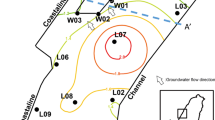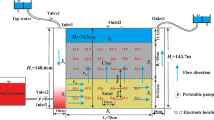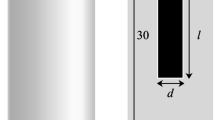Abstract
Two single-well injection–extraction (“push–pull”) tracer tests were performed in a groundwater monitoring well located in the Horonobe coastal sedimentary basin, Japan. The aim of the experiment was to investigate the in situ behavior of groundwater constituents when different mineralized fluids intrude into the aquifer (e.g., through a dynamic saltwater–freshwater interface). Artificially produced brackish water was used as the test fluid in the first experiment and deionized water in the second. Results from mixing models strongly suggest rapid mobilization and demobilization of ions within the aquifer as a reaction to the intruding fluids. Hydraulic modeling of the conservative chloride ions yielded effective porosities of about 1 %. These results show that the transport of ions is dependent on the composition and mineralization of the fluid. The refreshening of an aquifer leads to increased mobilization of ions and, in addition, to an increase of dispersivity due to clay swelling. This has consequences not only for dynamic saltwater–freshwater systems (aquifers in coastal areas and aquifer storage and recovery systems), but also for all systems in which chemically altered fluids come into contact within an aquifer (as, for example, can occur during geothermal heat/energy generation, or during CO2 storage).












Similar content being viewed by others
References
Bear J, Verruijt A (1987) Modeling Groundwater Flow and Pollution—Theory and Applications of Transport in Porous Media. D. Reidel Publishing Company
den Iseger P (2006) Numerical transform inversion using Gaussian quadrature. Probab Eng Inf Sci 20(1):1–44
DIN ISO 18130-1:1998-05 (1998) Baugrund—Untersuchung von Bodenproben: Bestimmung des Wasserdurchlässigkeitsbeiwerts—Teil 1: Laborversuche (Soil—investigation and testing: Determination of the coefficient of water permeability—Part 1: Laboratory tests)
Edmunds W, Smedley P (2013) Fluoride in Natural Waters. In: Selinus O (ed) Essentials of medical geology. Springer, Netherlands, pp 311–336
Gelhar LW, Collins MA (1971) General analysis of longitudinal dispersion in nonuniform flow. Water Resour Res 7(6):1511–1521
Haggerty R, Schroth MH, Istok JD (1998) Simplified method of “push–pull” test data analysis for determining in situ reaction rate coefficients. Ground Water 36(2):314–324
Haggerty R, Fleming S, McKenna SA (2000) STAMMT-R: Solute Transport and Multirate Mass Transfer in Radial Coordinates: a FORTRAN Code for Modeling and Analyzing Radial Single-well and Two-well Tracer Tests in Formations Exhibiting Multiples [i.e. Multiple] Rates of Diffusive Mass Transfer. Version 1.01, Rep. SAND99-0164, Sandia National Laboratories, Albuquerque, N. M., USA
Hall SH, Luttrell SP, Cronin WE (1991) A method for estimating effective porosity and groundwater velocity. Ground Water 29(2):171–174
Hebig KH, Ito N, Scheytt T, Marui A (2012) Review: deep groundwater research with focus on Germany. Hydrogeol J 20(2):227–243
Hebig KH, Zeilfelder S, Ito N, Machida I, Marui A, Scheytt TJ (2015) Study of the effects of the chaser in push-pull tracer tests by using temporal moment analysis. Geothermics 54:43–53
H-Rise Institute Horonobe (2010) Oral presentation, September 29, 2010
Ikawa R, Machida I, Koshigai M, Nishizaki S, Marui A (2014) Coastal aquifer system in late Pleistocene to Holocene deposits at Horonobe in Hokkaido, Japan. Hydrogeol J 22:987–1002
Konikow LF, August LL, Voss CI (2001) Effects of clay dispersion on aquifer storage and recovery in coastal aquifers. Transp Porous Media 43(1):45–64
Kumar PJS, Jegathambal P, Nair S, James EJ (2015) Temperature and pH dependent geochemical modeling of fluoride mobilization in the groundwater of a crystalline aquifer in southern India. J Geochem Explor 156:1–9
Mehnert E, Jennings AA (1985) The effect of salinity-dependent hydraulic conductivity on saltwater intrusion episodes. J Hydrol 80(3–4):283–297
Niizato T, Funaki H, Yasue K (2007) Paleogeography and geological evolution since the Late Pliocene in and around the Horonobe area, northern Hokkaido (in Japanese with English Abstract). J Geol Soc Jpn 113:S119–S135
Ueda T, Mitsuhata Y, Uchida T, Marui A, Ohsawa K (2014) A new marine magnetotelluric measurement system in a shallow-water environment for hydrogeological study. J Appl Geophys 100:23–31
Vandenbohede A, Van Houtte E, Lebbe L (2008) Study of the feasibility of an aquifer storage and recovery system in a deep aquifer in Belgium. Hydrol Sci J 53:844–856
Vanderzalm JL, Page DW, Barry KE, Dillon PJ (2012) A comparison of the geochemical response to different managed aquifer recharge operations for injection of urban stormwater in a carbonate aquifer. Appl Geochem 25:1350–1360
Yang C, Park M, Zhu C (2007) A method for estimating in situ reaction rates from push–pull experiments for arbitrary solute background concentrations. Environ Eng Geosci 13:345–354
Yang C, Mickler PJ, Reedy R, Scanlon BR, Romanak KD, Nicot J-P, Hovorka SD, Trevino Rh, Larson. T (2013) Single-well push-pull test for assessing potential impacts of CO2 leakage on groundwater quality in a shallow Gulf Coast aquifer in Cranfield. Miss Int J Greenh Gas Control 18:375–387
Acknowledgments
The authors would like to thank Mr. Masamitsu Yoshioka (Suncoh Consultant Inc.) and his team for their very helpful and straightforward technical support during the fieldwork. The authors would also like to thank the Horonobe Research Institute for the Subsurface Environment (HRISE), in particular Dr. Seiichiro Ioka (now Prof. at Hirosaki University) and Prof. Yoji Ishijima, for their logistical support and for valuable background information concerning the groundwater system of the Horonobe basin. The authors also would like to thank two anonymous reviewers for their useful comments.
Author information
Authors and Affiliations
Corresponding author
Rights and permissions
About this article
Cite this article
Hebig, K.H., Ito, N., Tecklenburg, J. et al. Use of single-well push–pull tracer tests to simulate a dynamic saltwater–freshwater interface. Environ Earth Sci 75, 281 (2016). https://doi.org/10.1007/s12665-015-4999-x
Received:
Accepted:
Published:
DOI: https://doi.org/10.1007/s12665-015-4999-x




